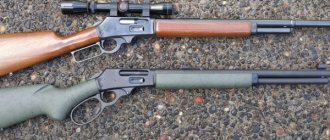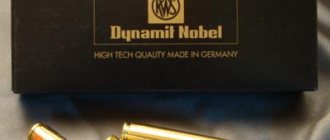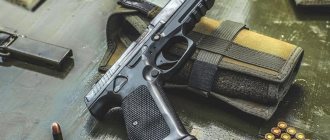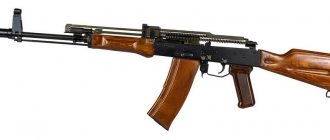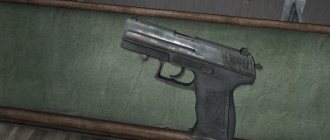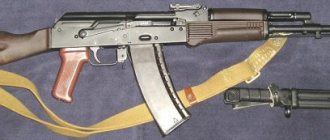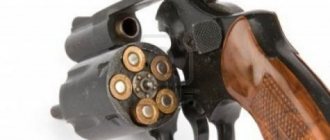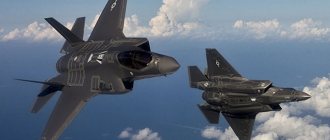Cartridge .444 Marlin / 10.7x56R
| .444 Marlin |
The .444 Marlin cartridge is designated: .444 Marlin / .444 Marlin Semi Rim / 10.7x56R Marlin / SAA 6910 / XCR 11 056 CDC 010.
.444 Marlin
The .444 Marlin cartridge was originally developed by Marlin in 1964 for the lever action carbine. Marlin Model 336 bolt.
The .444 Marlin is a stretched version of the then common .44 Magnum revolver cartridge. The diameters of the base of the case and the bullet of both cartridges are identical (.429″ or 10.9 mm), the only difference is in the length of the case, which for the .444 is 56.52 mm.
The design of the new cartridge was finally established as a result of joint efforts between Marlin and Remington.
By equipping it with a blunt-pointed semi-jacketed bullet weighing 15.55 g, Remington created the first factory cartridge of a new caliber in which the powder gas pressure does not exceed 3100 bar.
.444 Marlin
Muzzle energy of about 4000 J in combination with the presented carbine allowed the .444 Marlin cartridge to quickly win the love of Americans as a very lethal short-range cartridge. It is more powerful than the .30-30 or .35 Remington, and is similar in muzzle energy to the .348 Win. and .358 Win., but at the same time it has a much larger bullet diameter and therefore is much superior to the mentioned cartridges in stopping effect. The .444 Marlin was especially highly appreciated for its excellent stopping power in the northern states of America and Alaska, where it was used when hunting such dangerous animals as bears, as a support weapon.
This cartridge has also become popular in France for the most common type of big game hunting. High bullet speed is not required for such hunting, and the main advantage of this cartridge is the mass of bullets.
Weapons chambered for .444 Marlin can also be used for taiga hunting for elk, deer, wild boar, and bear, when a compact, powerful weapon with a reliable stopping effect for short-range shooting is needed.
.444 Marlin
The first model Marlin 336 carbine with a 61 cm barrel and a 2-3 round magazine gradually evolved into the more modern model 444SS with a 56 cm barrel and a 5 round magazine. Aside from a couple of choke models produced in small numbers, the use of the .444 caliber cartridge was limited to Marlin carbines for over 30 years. Only at the end of the 20th century, with the growing popularity of hunting dangerous animals and the mass passion for the exotic “Wild West”, carbines of the Winchester 94 series (mod. “Big Bore” and “Black Shadow Big Bore”) and Marlin 444P (mod. "Outfitter")
The .444 Marlin cartridge has a cylindrical case with a rim, a Large Rifle type capsule, a maximum bullet diameter of 10.90 (.429″), case and cartridge lengths of 56.515 mm and 65.28 mm, respectively, and a barrel rifling pitch of 38 inches. A factory cartridge from Remington with a semi-jacketed bullet weighing 15.5 g and a charge of IMR4198 powder of 3.05 g, has an initial speed and energy of 716 m/s and 3993 J, respectively, and a powder gas pressure of 3100 bar. Case trimming - up to 56.388 mm. When shooting at the optimal zeroing distance for this cartridge - 100 m, the bullet deviates from the aiming line no more: at a distance of 50 m - +3.0 cm, 150 m - -9.0.0.
The .444 Marlin cartridge was produced by Remington.
| .444 Marlin |
The Ballad of the Winchester: Marlin vs. Winchester
Carbine "Marlin" M1893 chambered for .32 HPS (.32 special high energy) cartridges
“They built their wall,” answered the mandarin, “in the shape of a pig!”
Understand? The wall of our city is built like an orange. Their pig will greedily devour us! - Oh. - And both thought for a long time. (“Golden Serpent, Silver Wind” by Ray Bradbury. Translator V. Serebryakov) Weapons and companies.
For some reason, it is believed that all rifles with a lever-controlled bolt are “Winchester”. However, in reality this is far from the case.
Moreover, the entire history of this company after 1876 has been a continuous struggle with a number of other companies that also produced the same rifles. In some ways they were better, in some ways worse, but they were there. And one of the most successful and largest was Marlin Firearms Co.
It would seem, what could Marlin do that Winchester could not do?
But it turned out that there is no limit to improvement. And that even the design of the “hard drive”, excellent in its simplicity and reliability, can be improved even further.
This is how the window on the Marlin rifles opened to eject spent cartridges
However, before we talk about the rifles themselves, let’s get acquainted with the history of this company. Without a doubt, less known than the story of the same “Winchester”.
And it so happened that in 1870 J.M. Marlin created, the enterprise of which was located in New Haven (Connecticut).
"Marlin" 1881 chambered for .45-70. It looks like a Winchester, it also ejects cartridges upward, and it looks a little rough.
As early as 1881, Marlin introduced its first lever-action rifle, its response to the growing demand for reliable repeating rifles, which only increased year after year after the Civil War.
But this is a 1948 Marlin M336 chambered for Winchester .30-30 cartridges. An elegant weapon, isn't it?
In 1886, the company introduced its unique two-piece, lever-actuated striker safety, which is still used in its rifles today.
In fact, this mechanism became the “grandfather” of each of all modern Marlin lever mechanisms. As you can see, the company has taken to competing with the famous Winchester in the most serious way. And she began to release her models at the same time as him.
Model 1893 barrel markings designed to fire smokeless powder cartridges
And here we should be more sensitive, let’s say, to the demands of the market. And I felt better about new trends in weapons manufacturing, compared to the same “Winchester”.
So, despite the collaboration with John Moses Browning, the design of the receiver remained essentially old. But the spent cartridges were thrown upward from it. The only difference was that on the 1873 and 1876 models the holes for the cartridges were located on the top panel of the receiver, and on the Browning Winchesters of 1886, 1892 and 1894. he wasn't there at all. The cartridge case was pulled out of the chamber by the bolt and thrown upward by the extractor.
Bolt box of the Marlin M336 rifle. Interestingly, the boss under the receiver for attaching the lever is very similar to a similar part on the receiver of early Winchesters. On later samples, J. Browning abandoned it.
And this was not very good, because it made it difficult to attach telescopic sights to the receiver, which just at that time began to gradually come into fashion, again based on the experience of the Civil War. In addition, the shutter open at the top was easier to clog.
"Marlin" M336. Right view. The shutter is open. It is clearly seen that the control lever design is simpler than that of the Winchester rifles, including those created by J. Browning. The shutter is cylindrical. Locking is done by a wedge that fits into a rectangular groove located on the underside of the bolt stem, closer to the shank of the firing pin. During locking, the firing pin parts are locked, so a shot is only possible if the bolt is locked. A locking wedge on the lever - it couldn't be simpler.
View of the receiver on the left
And so the experts thought about it. And it ended with the fact that in 1889 another “Marlin” entered the market, which had a receiver with a solid top and a side hole for spent cartridges on the receiver on the right.
Thus, it became possible to mount an optical sight on top of the 1889 model. And besides, the rifle mechanism itself was reliably protected from contamination.
The design was immediately patented and became a characteristic feature of all subsequent “marlins”.
The first rifles of this type were chambered for .32 (7.7 mm) and .45 (11.43 mm) calibers, but then their range was significantly expanded.
"Marlin" M336. Left view. As you can see, the carbine has swivels
In 1891 - the great success of model 39 22LR. And this rifle itself became the most famous firearm in US history that would have been produced continuously.
"Marlin" M39 chambered for .22LR
Cartridge 22LR (5.6×15.6 mm R (rimmed), LR – “long rifle”)
In 1894, this rifle combined all previous innovations into one reliable platform, including a wedge-locking bolt, two-piece firing pin safety, side ejection, and the strongest, smoothest receiver the industry had ever seen.
In 1895, the evolution of the Model 1894 continued. To use higher-power cartridges, the receiver, barrel and magazine were enlarged, which, accordingly, also became larger in diameter.
M336 barrel and magazine
In 1948, the Model 336 rifle appeared, featuring a round bolt (not the rectangular one of its predecessors) and an improved "Micro-Groove" barrel rifling (with 12 fine grooves) combined with a very carefully crafted lever action.
The trigger on the M336 is very unusual. It has a side projection that allows you to cock it with one finger with great convenience.
In 1965, the Model 444 was introduced for big game hunting.
Interestingly, the company consistently improved its models by adding one number to the name. First there was model 36, then 336. Pictured is M36AC
In 2022, it updated the M1894, improving its production technology.
In 2022, Marlin is releasing its “Black Series” - black rifles for modern hunters, containing many non-standard technical solutions and aesthetic improvements that were previously absent on this weapons platform.
Coaxial machine gun mount of two Marlin machine guns on board a De Haviland aircraft, Langley, Virginia, 1921.
Previously, namely in 2007, Marlin Firearms was purchased by Remington Arms, part of the Remington Outdoor Company.
However, Remington went bankrupt and was purchased in 2022 by Sturm, Ruger & Co.
During World War I, it became one of the largest manufacturers of machine guns in the world for the United States and its allies. It was the company that produced the Colt-Browning M1895 machine gun and its later version, called the Marlin machine gun, optimized for use on aircraft.
During the Second World War, it also produced 15,000 UDM42 submachine guns (but it was already discussed at VO).
In the 1980s and 1990s, Marlin finally began to outperform in terms of sales.
It was the flat top receiver, which made scopes easier to mount than traditional Winchester sights, that helped the company capture a larger share of the American market as American shooters became increasingly reliant on optics.
At the same time, Marlin rifles are larger and much stronger, although heavier than most similar models. Thanks to this, they can use very powerful cartridges, such as .45-70.
However, the Marlin M1894 rifles and carbines are also produced in pistol calibers, in particular, .357 Magnum, .44 Magnum and .41 Magnum, which allows them to be used in conjunction with revolvers chambered for these cartridges.
In 2008, Marlin produced its 30 millionth lever action rifle, which was donated by the National Rifle Association.
PS
Photos provided by Alain Daubresse.
To be continued…
Laser sighting cartridge Red-I .444 Marlin
INSTRUCTIONS
Unscrew the bottom of the laser cartridge case counterclockwise, which also serves as the battery compartment cover, install the batteries (included in the kit) with the positive pole towards the bottom, reinstall and screw the bottom cover back on.
Attention!
To ensure normal contact in the power system, it is necessary to clean the contact surfaces of the batteries. They are coated with a colorless protective varnish. If this is not done, then the laser diode may glow dimly due to voltage loss at bad contacts.
Using the complex to monitor the state of an already completed “hot” shooting of a weapon
We assume that the weapon was just shot at the required distance “hot”, that is, with real ammunition.
1. Place the Red-i laser cartridge either into the magazine of your weapon or directly into the chamber.
2. Lock the bolt of the weapon. The electrical circuit will close, and the laser beam, shining through the barrel bore, will form an image of a red dot on any surface.
3. Select a flat vertical surface at a distance of about 22-26 m (usually 25 m) from you and direct the laser beam at it. On a bright sunny day, it is recommended to choose a dark surface or a surface treated with a fluorescent compound that returns light well (for example, a road sign or sign). The best results are achieved by using a special reflective target from StoneyPoint (not included). A special reflective coating on the target, similar to that on road signs, ensures excellent visibility of the laser beam point, even in bright sunlight, even at relatively long distances.
The target is made on a self-adhesive base and can be glued to any smooth surface.
4. Observing the red dot on the surface through an optical (or any other) sight, sketch its position relative to the crosshair of the aiming mark (or the luminous dot of a red dot sight, or the front sight of an open sight) on the attached card. For your sight-weapon-cartridge complex, the position of the laser dot and crosshair is a constant.
5. In the future, wherever you are - at the shooting range, at the shooting range or on the hunt, you will be able, using the Red-i laser cartridge and the picture on the card, to find out whether the position of your sight on the weapon has been preserved, as well as the result of entering corrections in during “hot” zeroing after transportation or not, and if necessary, by means of adjusting the sight, ensure that the position of the crosshair of the aiming mark relative to the red dot is consistent with that documented on the card.
Naturally, the verification procedure must be performed at the same distance, i.e. about 25 m.
Using the complex for initial “cold” shooting of weapons
In order to correctly perform “cold” zeroing, you need to know the ballistic characteristics of your ammunition.
The aiming line intersects with the bullet's flight path in two places. BUT only in one place can the laser line, which continues the axis of the barrel bore, intersect (at this distance, this is actually the bullet’s flight line) and the aiming line - this point in ballistics is called the “near” zero. Knowing the ballistic characteristics of your ammunition, you can find out at what distance the aiming line intersects with the bullet’s flight path for the first time. Usually this happens at a distance of just about 22-26 meters. It is at this distance that “cold” zeroing is easiest to perform. The use of a retroreflective target with divisions allows you to perform “cold” zeroing at a different distance, for which the height of the trajectory above (or below) the aiming line is known.
In a small room, “cold” zeroing can be performed at a distance of 12.5 meters.
At this distance the laser point should be 25mm below the aiming point.
Using the training complex
Activate the laser and aim at a target located at a distance of no closer than 50 m. Try to hold the weapon as stable as possible. You will be able to evaluate how the barrel “walks” based on the movement of the laser dot and take measures to hold the weapon more stable.
Another exercise is performed with the help of an assistant, who must block the laser beam at the exit from the barrel bore with some opaque object. Aim at the target and ask your assistant to release the barrel. You will see where the bullet will actually go.
Possible problems
If, after a “cold” zeroing using the Red-i complex, the center of the group of holes when firing with real ammunition does not coincide with the center of the target, this does not mean that you received a faulty device. The reason could be either a slight loss of the barrel (this happens rarely), or a slight misalignment of the chamber with the bore (this happens quite often).
The problem is solved as follows: perform a “hot” zero, then insert a Red-i laser cartridge into the chamber, activate the laser and sketch the position of the laser dot relative to the crosshairs of the sight at a distance of about 22-26 meters. In the future, when carrying out “cold” zeroing, you should achieve the same location of the point relative to the aiming mark.
If the laser does not turn on, this may be due to the sinking of the brass contact cylinder located in the steel bottom-cover when the weapon's bolt is released under the impact of the striker. If this happens, unscrew the bottom cover and press down the brass contact from the inside with light blows of a hammer through the spacer. Attention!
Do not use a reflective target when cold zeroing night sights! This can lead to serious problems with image intensifier tubes (the laser beam is reflected into the device and burns out the cathode phosphor).

